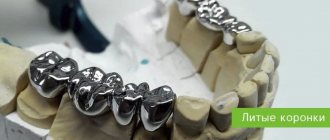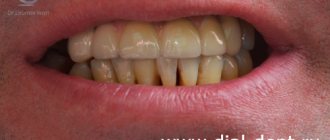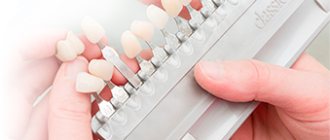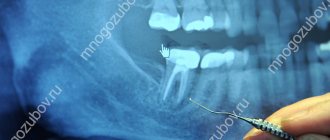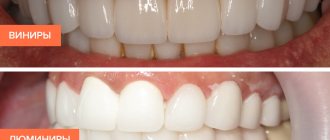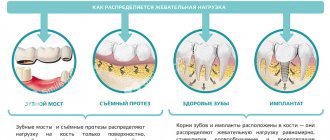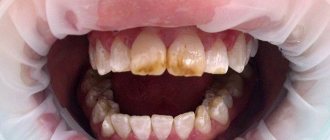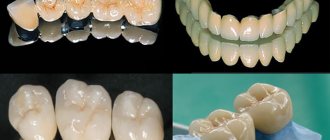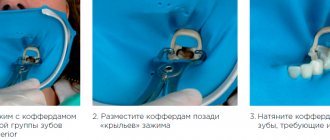Dentists spend a lot of time developing methods to maintain not only a healthy, but also a beautiful smile. Aesthetic dentistry is a special direction in which the main efforts are aimed at restoring the natural beauty of teeth. One of the common methods used for this purpose is tooth restoration with composite material .
The procedure involves the installation of modern, individually selected photopolymer fillings that are indistinguishable from natural teeth even by dentists. In St. Petersburg, the service is provided by the Nurimed clinic, where experienced doctors work who take on clinical cases of any complexity. You can make an appointment or clarify the information you are interested in by calling: +7 (965) 067-04-26, or via online chat.
Who is undergoing the procedure?
Anyone can sign up for artistic restoration of the dentition or part of it. Common indications for restoration techniques:
- Cracks;
- Chips;
- Partial destruction;
- Carious lesions of varying neglect;
- Non-carious lesions that change the appearance of the dentition;
- Darkening of the enamel;
- The appearance of black spots on the teeth;
- Blackening or any other discoloration of the enamel.
If the client is dissatisfied with the external condition of the teeth, then Nurimed dentists will make an aesthetic restoration. At the same time, each patient is comprehensively examined, excluding contraindications to the procedure.
Creating veneers: key steps
During the first visit to the clinic, the patient prepares a tooth for veneering, takes an impression, selects the color of the ceramic material to match the rest of the teeth, and installs a temporary veneer. Within one to two weeks, a ceramic veneer is made in the laboratory, which is installed for the patient during the second visit to the clinic.
The veneer of the tooth must be strong, so the veneer is 0.5-0.7 mm thick. To ensure that the restored tooth does not stand out from the row, a layer of enamel must be removed from its surface to the appropriate depth. The tooth is prepared so that the veneer is tightly and securely attached to its surface.
After removing the layer of enamel under the veneer, the dentist takes an impression of the tooth using a special material - usually impression paste. Once the material has hardened, the impression is ready and removed from the tooth. Using individual casts, specialists in the laboratory using the casting method prepare a plaster model - a copy of the tooth to be restored. The veneer made by specialists must fit the model perfectly.
The shade of the cladding is selected using a color chart - a special set of porcelain plates of various shades. This allows you to make a veneer that will not visually differ in color from neighboring teeth.
Making porcelain veneers takes a certain amount of time, usually up to two weeks. To prevent the ground tooth from causing inconvenience to the patient (it may have a sharp edge, react to the temperature of food, etc.), it is covered with a temporary veneer, which the dentist makes himself during the patient’s first visit. In some cases, temporary cladding is not installed for some reason. You should avoid putting stress on the tooth with a temporary veneer - such veneer can easily break or come off.
Before installing a permanent porcelain veneer, the dentist needs to check the tight fit of the facing plate to the ground tooth, evaluate the shape of the veneer, and compare its shade with the color of the teeth in the neighborhood. For this purpose, the finished veneer is applied to the tooth, then removed and, if necessary, adjusted. The adjustment continues until the veneer fits snugly against the tooth.
During the fitting process, it is necessary to check the bite - the tooth with the veneer must fit correctly with the rest of the teeth. A well-fitted veneer is cemented onto the tooth; to do this, the contacting surfaces must first be thoroughly cleaned. Then the enamel is etched using a special gel - as a result, the tooth surface becomes rough, which improves adhesion. Next, a layer of cement is applied to the tooth, on top of which a veneer is installed. The doctor removes excess cement squeezed out when attaching the cladding. After the adhesive has hardened, the veneer is considered fully installed.
To whom is the technique contraindicated?
Artistic restoration of teeth with composite material is not possible for all clients, since the technique has a number of contraindications (some of them are temporary and correctable):
- Allergic reaction to the composite;
- Installed pacemaker;
- Some individual characteristics that prevent the sealing of a carious cavity;
- Poor oral hygiene;
- Night grinding of teeth (bruxism);
- Pathological bite;
- Excessive abrasion of tooth enamel;
- Frequent stay in traumatic conditions (athletes, rescuers, etc.).
By registering with Nurimed, clients can be calm about their own safety and the results of the procedure, since the clinic’s doctors individually assess the risks and benefits for everyone.
Dental care with veneers
The service life of a veneer is more than 10 years, provided proper care and systematic checks by a dentist. Experts recommend:
- Clean your teeth daily using a brush and floss to avoid the occurrence of caries in veneered teeth;
- Avoid excessive force on teeth with veneers - do not bite your nails, do not bite threads, do not crack nuts, etc. Otherwise, it is difficult to avoid the porcelain plate being displaced or broken.
Aesthetic dentistry from the Interdentos dental laboratory provides for the production of ceramic veneers at attractive prices.
Advantages of the method
Our dental center prefers composite correction for patients due to a number of its advantages:
- An ideal aesthetic result, since it is possible to select a material that completely imitates natural tooth enamel.
- Helps to correct not only external beauty, but also restore chewing function. After restoration, a person can eat any food without fear of pain or discomfort.
- The correction speed is high. One visit to the dentist is enough to restore several teeth. Especially when it comes to a modernly equipped clinic.
- Allows you to preserve the maximum amount of healthy tissue. A very gentle option for restoring a smile.
- Moderate cost of the service. Despite a number of listed advantages, the price of restoration remains affordable to every client.
Options for solving the problem of restoring cavities in the chewing teeth
General practitioner Anna Blokhina
, specialist of the Federal State Institution “Consultative and Diagnostic Center with a Clinic” under the Administration of the President of the Russian Federation” (St. Petersburg)
Solutions to the problem of restoring cavities in posterior teeth
Therapist
Anna Blokhina
, a specialist of FGU Advisory and Diagnostic Center & Polyclinic in managing the affairs of the Russian President (St. Petersburg)
Summary.
In most clinical situations, allowing the restoration of the teeth of the side group after removal of tooth pulp direct composite restorations, the problem of shrinkage during polymerization is still relevant. The solution to this problem was made possible with the advent of new material SDR (smart dentin replacement) – under the rational dentin. He has a winning physical and mechanical properties: compressive strength, high modulus of elasticity, resistance to the development of cracks and other convenient fluid texture and provide a self-adaptive property of the completion of any irregularities and undercuts in the cavity. And the opportunity to make SDR layers up to 4 mm can quickly fill in the missing amount of dentin 2–3 servings.
Volumetric restoration of cavities in the teeth of the chewing group is a typical clinical situation encountered every day in dental practice. It is often difficult to motivate a patient to restore posterior teeth with a decay rate of approximately 50% (for example, mesial-occlusal-distal) using indirect prosthetics such as ceramic or composite inlays. In addition, extensive restoration of teeth in the chewing group involves considerable time expenditure. In such a situation, several tasks arise at once - not only to ensure the reliability, durability of the restoration for a long time and optimal aesthetics, but also to save time on restoration.
In most clinical situations, composite materials are used for direct restorations. In recent years, the use of composites has increased significantly due to the improvement of their aesthetic and physical-mechanical properties. But, nevertheless, the problem of material shrinkage during polymerization remains relevant [2]. At first glance, the difference between polymerization shrinkage and polymerization stress is not obvious. However, the negative consequences that shrinkage creates are only the result of polymerization stress. Thus, these concepts are not synonymous, although they are in a cause-and-effect relationship.
Polymerization shrinkage
– percentage reduction in the volume of the material relative to the original during the polymerization reaction. The value of polymerization shrinkage of composites is directly related to the amount of inorganic filler in their composition. Any composite material includes three components: an organic matrix, an inorganic filler and surfactants (silanes). An increase in the percentage of filler in the total mass of the material leads to a decrease in the organic component involved in the polymerization reaction and, accordingly, to a decrease in shrinkage of the material. However, on the other hand, an excessive increase in the number of inorganic particles leads to an increase in the hardness of the material and, as a consequence, to an increase in stress in it and a change in its properties in a negative direction. Thus, the struggle to reduce polymerization shrinkage cannot be considered a universal key to improving the properties of the material.
Moreover, according to research data, in most composite materials, low shrinkage is accompanied by high polymerization stress and vice versa [3].
Polymerization stress
– the stress that the material experiences during the development of polymerization shrinkage.
In this case, the most vulnerable area is the zone at the boundary of the material and hard tissues ( Fig. 1
).
Polymerization stress during shrinkage can lead to such negative consequences as:
- postoperative sensitivity;
- violation of the marginal seal, marginal separation, change in color of the restoration [5];
- development of caries relapse;
- the appearance of cracks and chips due to disruption of the structure of hard tissues;
- loss of restoration.
The problem of polymerization stress is especially relevant in cavities that have high C-factor values (cavity configuration factor), which reflects the interaction between the design of the cavity and the ability of the material to reduce stress due to elastic deformation of its walls [7]. Any cavity has five walls ( Fig. 2
).
The C-factor is calculated as the ratio of the number of bound surfaces of the SVBP (interacting with the material during polymerization) to the number of free surfaces of the SVBP. The more walls interact with the material during polymerization, the higher the C-factor, the greater the polymerization stress develops in the cavity during the curing process. The most unfavorable in this regard are cavities of class I and V ( Fig. 3
), since they have five connected surfaces and one free one [7].
Options for volumetric restoration of cavities using direct restoration
To restore cavities with direct restoration, two methods are used today:
- sandwich technique – a combination of glass ionomer cement (GIC) and composite [4];
- layered restoration technique – a combination of composites with different elastic moduli.
Sandwich technique
involves introducing GIC to the enamel-dentin border (usually in one portion) and restoring the enamel with a composite material (
Fig. 4
).
Volumetric restoration of chewing teeth using the sandwich technique has a number of positive properties due to the use of glass ionomers:
- compensation of material shrinkage due to hygroscopic expansion;
- preventive release of fluoride ions;
- chemical bond with dentin (although the adhesion force does not exceed 10–14 MPa);
- possibility of introducing material in large portions.
However, there are also negative parameters for using GIC in sandwich technology:
- GIC is inferior to composites in a number of strength characteristics [6];
- the restoration procedure is labor-intensive, multi-stage and time-consuming (this is due to the fact that it is first necessary to use the adhesive system for the glass ionomer, then add the glass ionomer, then apply the adhesive system for the composite and, finally, add the composite);
- low abrasion resistance, which does not allow leaving the GIC without covering it with a layer of composite on the occlusal surface, as well as restoring contact points using the open sandwich technique;
- the adhesion force between the “GIC - composite” layers is inferior to the adhesion force between the “composite - composite” layers (materials of the same methyl methacrylate chemical nature).
With layered restoration technique
in the case of class I cavities, when the C-factor is 5, to compensate for high polymerization stress, it is recommended to use a layer of low-modulus flowable composite as a liner with a thickness of no more than 1–2 mm (
Fig. 5
).
Flowable composites are highly elastic and cause lower stress compared to conventional composites due to their lower inorganic filler content. But high polymerization shrinkage (5% and above) and low abrasion resistance do not allow their use as the main material for restoring cavities with a high C-factor.
After applying the adaptation layer of the flowable composite, further restoration of the cavity is performed using composites of traditional consistency. To compensate for polymerization stress and the C-factor, it is better to carry out restoration with composites using the triangle technique, which involves adding material to no more than 1–2 surfaces at a time ( Fig. 6
). The second reason for layer-by-layer application of the composite in small layers is the possible depth of polymerization of the material, which is 2–3 mm for standard composites. In other words, volumetric restoration of cavities using the layered restoration technique is an even more labor-intensive and time-consuming process than the sandwich technique.
Material required for volume restoration of cavities
The most suitable material for restoring volumetric cavities of class I–II would be a material with the following characteristics:
- with shrinkage rates that would not lead to the development of significant polymerization stress;
- with a consistency close to a flowable composite, for ease of application and ensuring high elasticity of the material;
- with the ability to add material in large portions, like glass ionomer in sandwich technology to save time;
- with strength properties corresponding to significant occlusal load in the masticatory regions.
The solution to this problem became possible with the advent of the new material SDR (smart dentin replacement) - a rational dentin substitute.
Advantages of SDR material
New principle of filling cavities by reducing polymerization stress by up to 60%
The SDR modulator included in the material interacts with the polymerization initiator camphorquinone, thereby regulating the reaction kinetics. When interacting with camphorquinone, the growth of the elastic modulus slows down. This smooth type of polymerization was called soft-start chemical polymerization. With SDR material, the polymerization stress of the material is reduced by up to 60% (≈1.5 MPa). For comparison: polymerization of flowable composites leads to the development of stress up to 4.5 MPa, standard microhybrids - up to 3 MPa (even using the triangle technique).
A significant reduction in stress during polymerization allows the material to be added in layers of up to 4 mm, which corresponds to the depth of a standard cavity according to class I–II [5]. In this case, there is no need to first introduce an adaptive layer of a flowable composite. It is recommended to introduce the SDR material up to the enamel-dentin border and restore the enamel and cusps with a universal composite ( Fig. 7
).
Compatibility of the SDR material with any adhesive system and composite material based on
methyl methacrylate resins
SDR, being a hybrid in structure, has a standard methyl methacrylate organic matrix. Due to this, 100% compatibility of the material is achieved with any standard adhesive systems (both self-etching and total etching techniques) and composite materials based on methyl methacrylate resins [4]. When restoring using the SDR technique, the doctor does not have to abandon the usual adhesive system and the previously selected traditional composite - all components are combined with SDR.
Physical and mechanical properties of the material aimed at volumetric restoration of cavities
The main indicators characterizing the strength properties of a material include compression strength, elastic modulus, bending strength, and resistance to crack development.
Compressive strength
SDR is 245 MPa, which is close to the properties of natural dentin (276 MPa).
The wear resistance of the material in the proximal
zone
, according to long-term research results, corresponds to the average performance of most hybrid composites. Therefore, SDR is indicated when filling class II cavities with restoration of contact points.
But if this material has sufficient wear resistance, why is it recommended to restore enamel and bumps with another universal composite? Firstly, restoration of occlusal anatomy using SDR is difficult due to the fluid consistency of the material and due to its self-adaptation (this will be discussed below).
Secondly, the wear resistance of the SDR material under enormous occlusal load in the masticatory region is inferior to that of composites of traditional consistency due to the less fullness of the material.
A number of generalized independent studies [6] revealed the advantages of the SDR material compared to GIC with a triple curing mechanism ( table
).
Thus, from the point of view of the physical and mechanical properties of materials, volumetric restoration of cavities according to class I–II is preferable in the SDR technique rather than in the sandwich technique.
Liquid consistency of SDR and self-adapting property
SDR has a liquid consistency, which allows it to be applied in one portion without additional condensation in the cavities. In addition, fluidity provides improved adaptation of the material to the cavity walls. The self-adaptation property - leveling the surface of the material after application - allows you to get rid of the problem of controlling the homogeneity of SDR when applying in large portions. No spreading of material with a probe is required. This property also allows you to control the application in the undercut area, at the border with the hard tissues of the tooth, which is especially important when restoring distally located cavities according to class II, when the work is carried out almost blindly. Along with the above, SDR has the property of thixotropy - thickening, which does not allow the material to flow out of the cavity when introduced in large portions, for example, into the area of the chewing teeth of the upper jaw.
Specially designed compules with a long
spout
allow you to apply material to hard-to-reach areas (
Fig. 8
)
Universal shade SDR
SDR material is produced in one shade – B1 on the Vita scale. The absence of a shade selection step during restoration simplifies the work and further saves time. The choice of shade B1 is not accidental. An increase in the saturation or opacity of a material indicates an increase in the amount of pigment in its composition. During the light-curing process, pigment-forming particles reflect light, preventing the material from fully polymerizing to a great depth. Therefore, when working with opaque and dark shades, material manufacturers recommend polymerization for a longer time, for example, not 20 s, but 40. Shade B1 has a minimal amount of pigment, which leads to homogeneous and rapid polymerization to a depth of 4 mm or more.
Radiopacity of hard tissues
High radiopacity of the material is a key indicator for facilitating diagnosis. The radiopacity of SDR is 2.2 mm Al, which exceeds that of most composite materials.
Indications for the use of SDR at a clinical appointment
Volumetric restoration of cavities according to class I–II
The simple and versatile SDR technique can significantly reduce recovery time. Filling the cavity to the enamel-dentin border will take 1–2 minutes. The time required to restore the enamel depends on the nature and volume of the cavity along the occlusal surface. The minutes saved can be spent on better finishing of the restoration, as this is one of the factors of its durability.
Restoration of narrow cavities according to class II and cavities with difficult visual control
The peculiarity of the localization of cavities according to class II is that the presence of a carious cavity on one proximal surface leads to the formation of a hidden carious defect on the adjacent tooth in almost 100% of cases. If the cavity on the adjacent tooth is of small depth, it can be gently prepared without reaching the occlusal surface or with minimal exposure within the marginal enamel ridge [5]. In the first case, restoration of the cavity does not require the use of a matrix system. With SDR, restoring such cavities is not difficult. The material is introduced in one portion and the cavity is restored in full, including the enamel on the proximal surface. The long spout of the compula allows you to do this easily even in areas that are difficult for visual inspection. In the case of minimal exposure of the carious cavity to the occlusal surface within the marginal ridges, a matrix system is required. However, this creates a rather narrow cavity into which it is difficult to introduce even the adhesive on the applicator. In this case, SDR also allows you to get out of the situation: the material is applied in one portion to the enamel-dentin border, then the enamel ridge is restored with a composite of normal consistency.
Application in vertical and horizontal tunnel techniques
Restoration using the tunnel technique involves minimally invasive preparation when localizing a carious lesion of medium depth on the proximal surface below the contact point [1]. Using the vertical tunnel technique
when preparing the approximal zone, operational access to the cavity is carried out through the occlusal surface in the area of the central fissure or triangular fossa, preserving intact hard tissues in the area of the marginal enamel ridge and contact point (
Fig. 9
).
In the horizontal tunnel technique, operational access is carried out from the buccal surface in the area where the carious cavity is located. In this case, minimally invasive preparation of the defect is again carried out with minimal removal of healthy hard tissue in the access zone ( Fig. 10
).
Both techniques are not universal for use due to the complexity of preparation, but in a number of clinical situations they have their advantages: conservative access, preservation of immune zones and the contact point, saving time during restoration (there is no need to restore the contact point with the classic setup of the matrix system). Initially, techniques were developed for the restoration of defects using glass ionomer cements, since these materials made it possible to fill the cavity in one portion and performed a preventive function in the proximal zone. But when restoring with classical composites, how can a cavity be restored blindly with layer-by-layer introduction of the composite in small portions of 2–3 mm? In the SDR technique, restoration is not difficult: the material is introduced into the cavity in one portion, and the enamel area is also restored with one portion of a traditional composite.
Conclusion
The use of SDR at the reception for 1.5 years made it possible to identify the following advantages of the material.
- Ease of use due to its convenient consistency, ability to self-adapt and the ability to fill undercuts and hard-to-reach areas in cavities of class I–II. The material does not require additional distribution.
- Absolute versatility of use due to compatibility with any adhesive system and any composite material.
- Significant time savings during restoration due to the ability to simultaneously apply SDR in portions of up to 4 mm and the absence of the need to use a flowable composite as a liner, as well as due to the absence of the step of re-applying the adhesive system during restoration. When comparing the time spent on restoring cavities of the same location and volume in the sandwich technique and the SDR technique, in the second case, a saving of about 6 minutes was revealed.
- High-quality marginal fit and preservation of contact points during long-term analysis of proximal surfaces.
- Optimal esthetics on proximal and occlusal surfaces, which, despite the higher transparency and brightness of SDR compared to standard microhybrids, does not affect the final appearance of the restoration.
Disadvantages of composite restoration
Each technique, therapeutic or aesthetic, has its drawbacks. For direct composite dental restoration this is:
- The resulting ideal color of the composite lasts approximately 3-4 years.
- The service life of new fillings is not long enough compared to porcelain material.
- Increased risk of formation of secondary carious lesions in comparison with ceramic structures.
- If the volume of restoration is very large, then this affects the strength. Ceramics are considered more reliable.
There is also a risk of choosing the wrong shade of the composite, which will differ from real enamel. However, the high qualifications and extensive experience of our dentists exclude such an unpleasant situation.
General overview
One of the main reasons for the occurrence of these dental problems is the inability to timely diagnose developing pathologies. The strength of the enamel structure of the chewing units is higher than that of the frontal incisors, and their location excludes the prompt detection of defects that are barely noticeable at first. As a result, the enamel coating, exposed to negative factors, is gradually destroyed - however, the patient pays attention to this process only after the onset of pain, or randomly, during a routine dental examination.
Restoration of the lateral groups of teeth is a complex of medical procedures used to restore the natural structure of the crown. The use of composite polymers, as well as prosthetic structures made from ceramics, zirconium dioxide, porcelain and other materials, makes it possible to compensate for the missing volume of dental tissue that has undergone irreversible changes.
Types of procedure
The choice of dental restoration technique depends on the individual characteristics of the clinical case. The following factors are taken into account: location of defects, extent, severity. Common types of restoration:
- Veneers. Restoration of the front teeth with composite material is carried out using veneers. They also come in ceramic, but such designs are much more expensive. Application is only possible for minor damage.
- Tabs. In this way, cavities formed in deep layers are closed. The technique is gradually losing its relevance, since the strength of such a restoration is not very high.
- Fillings. The installation is carried out regardless of the complexity of the clinical case. The most common and cheapest way, thanks to which it is easy to restore aesthetic comfort.
What can modern dentistry do?
Zirconium crowns installed today most often meet all the requirements for restoring the aesthetics and functionality of teeth. How long does the recovery effect last? This question is difficult to answer unequivocally, since much depends on dental care, nutrition and lifestyle of the patient. It is possible to prolong the effect of restoration by taking preventive measures given by the doctor after the dental restoration procedure.
The best dentists and dental clinics in Moscow offer high-quality dental crowns, reviews of which can be read on the Internet. It is important to understand that the benefits of implantation, dental care both before and after restoration is a determining factor in the health and whiteness of teeth. A fairly common problem for modern people is darkened enamel. Videos of dental crowns in dentistry can be viewed on the website. The reasons for darkening of the enamel are numerous, but in some cases it is impossible to correct the color defect with the help of bleaching. And this is where aesthetic dental restoration comes to the rescue, prices that can cope with even the most complex cosmetic tasks. Of course, the cost of implanting chewing teeth, as mentioned above, is affordable; it is very difficult to distinguish the tooth being restored on your own, even in the photo. Dental problems that can be easily treated by modern dentistry are quite numerous.
Among the most popular are diastema (interdental spaces), broken teeth, chips, cracks in teeth, stains and darkened areas on the enamel, “yellow” teeth, as well as other aesthetic problems on the front and side teeth. The service life of crowns and restorations allows you to solve numerous aesthetic problems, even in cases of significant destruction of the tooth or teeth. It is important to note that when several front teeth are destroyed, complete restoration is possible in the absence of contraindications to restoration. The choice of implantation technique, as well as the choice of implant system and the choice of crown system, is best left to the doctor.
How is restoration done with composites?
Stages of artistic correction in modern dental clinics:
- Removal of hard deposits and soft plaque;
- Selecting the appropriate color of the composite material;
- Local anesthesia;
- Removal of affected tissue and previously installed fillings;
- Creation of a dry working field;
- Treatment of the area with antiseptics;
- Creation of a crown by layer-by-layer application of filling material.
The last stage of correction is to adjust the crown to the specific patient. First, the shape is changed so that the patient does not feel discomfort when biting or chewing. The filling is then polished to a state identical to the enamel.
Scope of application of veneers
Modern dentistry has begun to resort to veneering teeth as an alternative to installing all-ceramic crowns. Making veneers is much simpler, takes less time and costs patients significantly less. Porcelain veneers are created in a laboratory (indirect method) and serve to improve the aesthetics of teeth.
Using veneers you can:
- hide any types of tooth enamel defects:
- fluorosis spots;
- changed color due to treatment with tetracycline;
- darkening of the enamel resulting from dental treatment using old methods or due to injury;
How much does the procedure cost?
The cost of the technique depends on the individual characteristics of the condition of the teeth nearby. What matters is: how much materials the dentist needs to spend, how difficult the patient’s situation is, and the type of restoration. Most often, clients sign up for restoration of anterior teeth with composite material, which is the most expensive.
At the Nurimed dental clinic, the price of the services provided does not exceed their quality. Sign up for artistic correction and again delight yourself and your loved ones with a bright smile.
Contraindications for use
The production of veneers is contraindicated if:
- caries is not cured;
- teeth are weakened due to gum disease or another reason;
- the enamel on the tooth is too thin;
- teething has not yet completed;
- the patient has a straight bite;
- The patient has bruxism (grinding or clenching of teeth).
Ceramic veneers are not installed on teeth with caries and when diagnosing periodontal diseases, otherwise the teeth under the veneer will quickly deteriorate. Installation of veneers is possible only after complete recovery from these diseases.
Porcelain veneers require grinding of the tooth, and if the enamel is already severely damaged by caries or has a serious chip, installing a veneer is not recommended - it will weaken the already fragile tooth, which will lead to its complete destruction. These teeth are restored using dental crowns. It is also not recommended to use veneers on teeth with a thin layer of enamel - it will not be enough to provide the necessary strength of the veneer.
The production of veneers is also contraindicated for bruxism: porcelain plates easily break due to excessive load when grinding teeth.
Veneer manufacturing sequence
Veneers require individual care! Avoid lever-like movements when biting food
- Determination of indications;
- Cleaning teeth from plaque, determining color;
- Photographic registration of images of the patient's face in front and profile with the mouth open and closed in the anterior region (this information helps the technician in planning future restoration);
- Taking diagnostic impressions and making models, recording central occlusion (habitual closure of the dentition);
- Wax planning of future restoration (WaxUp);
- Production of temporary veneers (if preparation is planned);
- Preparation with depth marking (the goal is to remove only the minimum volume of enamel necessary for applying and fixing the facets;
- Taking final working impressions, re-registration of central occlusion, temporary fixation of temporary structures made of composite or acrylic plastic;
- Production of veneers in a dental laboratory or milling center;
- Removal of temporary restorations;
- Application and fitting of the finished structure, assessment of quality, accuracy of marginal fit, contact with adjacent teeth and antagonists (teeth of the opposite jaw);
- Cleaning and preparing the tooth surface and veneers for permanent fixation;
- Isolation of the working field;
- Fixation with dual-curing composite cement (light and chemical);
- Removing excess material;
- Check and, if necessary, correct contacts.
Historical reference
Composite materials are modified plastics with improved aesthetic, strength and handling properties. Their connection with tooth tissues is due to adhesion.
Adhesion (Latin adhesio - fusion, adhesion) is the phenomenon of adhesion between two surfaces brought into contact. Systems created on the basis of this phenomenon are widely used in dentistry.
Currently, there are seven generations of these systems , with the fourth to seventh being used in clinical practice. They differ from each other in adhesion strength, the relationship of the components (separately or in combinations) and indications for use.
The widespread use of veneers dates back to the 1980s.
What are the advantages of composite veneers?
The main advantage of this type of tooth restoration is its low cost. The use of inexpensive composite material allows for restoration without the use of complex technologies.
The second significant advantage is the shortest possible time for carrying out the procedure. The installation process is completed in one visit to the dentist. In order to restore a tooth with such an onlay, a specialist does not need to take plaster casts and send them to a special laboratory. The material is applied layer by layer to the desired surface of the incisor, immediately in the dental chair.
But it's not that simple. Simple manufacturing technology entails significant disadvantages, which also need to be taken into account when choosing. The main one is that the pad has a low degree of adhesion to the surface of the cutter. This causes bacteria to multiply and plaque to accumulate, especially at the border between the veneer and the tooth. As a result, inflammation of the gums is provoked and caries forms.
If we compare composite veneers with ceramic ones, the aesthetic appearance of the former leaves much to be desired. The linings darken and become stained as their service life increases. When using them, the patient will have to strictly monitor food products, taking into account the presence of natural or natural dye in them.
I would also like to note the reliability of the composite material used. Its high fragility leads to the fact that the linings are ground down, acquiring a rough surface. And eating solid foods in the form of nuts or seeds can lead to the formation of cracks on the surface.
Methods for making veneers
- Injection pressing followed by sintering of ceramic mass (Dicor, IPS Empress);
- Vacuum firing on a refractory model (refractor);
- Milling on a computer-controlled machine from ready-made factory blocks - CAD/CAM (computer aided design and manufacturing). These are systems such as Cerec, Everest Procera, Cercon and In-Ceram, Vollceram, Hi-Ceram masses.
Advantages and disadvantages of veneers
